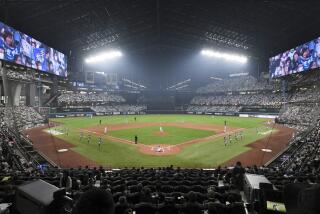Soft focus on Japan’s economic bender
TOKYO — Japanese audiences can be excused for feeling some nostalgia for the 1980s while watching “Bubble Fiction: Boom or Bust,” a new movie about those champagne days when a man could drape a Tiffany necklace around the neck of a woman he’d just met and friends would tell her to take it because “everyone’s got too much money anyway.”
Japan’s bubble era seems surreal in hindsight: too much cash, too much excessive consumption and zero recognition of the recklessness of those days.
It ended in tears, of course. Real estate prices collapsed. Banks failed. And Japan embarked on a long period of economic stagnation. Only in the last two years have economists declared the lost decade over, pointing to jumps in corporate profits and the vigor of Japanese stock markets.
To the makers of “Bubble Fiction,” the economic recovery signaled that the time had arrived for a satirical look at this national trauma. They figured that each new bit of happy economic news -- Toyota the World’s Biggest Carmaker! Tokyo Land Prices Up! -- makes Japanese audiences better equipped to look back at their folly with wry amusement instead of anguish.
“If we had made this movie five years ago, it would have been a much darker comedy,” said Yasuo Baba, the director. “Even last year, when the script was approved, we asked ourselves if it was an appropriate theme. There are many people out there who were burned by the bubble and still have bad feelings about it.”
Those wounds may be rawer than Baba realizes. Japan’s recovery remains heavily centered on Tokyo, with its head offices enjoying higher profits, and Nagoya, home to Toyota Motor Corp. Beyond that, the picture gets less rosy, with many cities and towns mired in debt and losing manufacturing jobs to countries such as China.
Japan’s core economic problem is that consumers are reluctant to start spending again. Some of that wariness can be explained by statistics that show higher corporate profits have not translated into higher wages for workers. Incomes remain virtually static.
And no one can miss the daily rumblings in the media about how Japan’s low birthrate points to a future of too few workers to fund a pension system for too many retirees.
But there may also be a subconscious factor at play: The collapse of the bubble still haunts Japanese attitudes. The word “bubble” still frequently pops up in conversations here. The experience has been seared onto the consciousness of a generation now in its late 30s, 40s and 50s, much the way the Great Depression’s misery dictated a lifetime of cautious spending habits for the millions it touched.
“People were spend-happy in the bubble days,” Baba said. “If you were a newly hired salaryman, the first thing you did was buy an Armani suit. But in the last 10 years, Japan has raised a generation that will not spend. It’s not an economic issue. It’s psychological.”
Baba knows the bubble era well, though he said he was not badly burned financially. His career was built on three hit romantic comedies made in the 1980s that captured the social essence of that time.
After a bit of a lost decade of his own during which he drew lots of “manga” comics but made only one movie, Baba has returned to that period with “Bubble Fiction.”
The movie was produced by Fuji TV, a media conglomerate known for unabashed entertainment values and a finger on the public mood. And for all the movie’s cartoonish violence and lack of serious tone -- the plot involves time travel back to 1990 in a washing machine -- it does offer a populist view of Japan’s current troubles.
“Bubble Fiction” portrays the Japan of 2007 as a dismal place. Economic hardship has pulled families apart and traditionally cohesive Japanese society has atomized, with people looking out only for themselves.
The movie opens with a debt collector harassing a woman named Mayumi at a funeral parlor as she grieves for her mother. He helps himself to the money in the condolence tray, an eerie reminder of the notoriously heavy-handed collection methods of Japan’s loan companies.
Desperate to get out of debt, Mayumi agrees to go back to 1990 on behalf of a small group of Finance Ministry bureaucrats. They want her to correct the bad political decision that popped the bubble and will, if left untreated, push 21st century Japan into bankruptcy and a social implosion.
And it’s in 1990 that we find the villains: foreign bankers and their Japanese collaborators in business and government who are orchestrating a collapse so they can scoop up assets on the cheap.
This has strong echoes of the current mood in Japan, where there is much muttering about foreign “vulture” capital firms buying fire-sale assets of buildings, golf courses and the like and reselling them at a profit. In a reversal of the bubble era, when Japanese firms were picking off American landmarks, these days it is U.S. hedge funds that scour Japan for bargain pearls.
Stories about American cherry-picking resonate beyond the business community, affecting a population that sees old economic certainties upended. Recognizing that popular interest, national broadcaster NHK has begun airing a drama on Saturday nights called “Hagetaka” (“The Vultures”). Also set in the early 1990s, it concerns a Japanese fund manager, seasoned with training in New York, who has returned home to troll for cheap assets.
This is the calamity that “Bubble Fiction” tries to undo with its time-travel trick. In the end, with the evil Japanese bureaucrat and his foreign cronies exposed, and the bubble’s bust averted, Mayumi returns to a different Japan of 2007. Prosperity has continued unbroken. Family values are still strong. Japan has even won a soccer World Cup.
“We spent the most money on that last scene,” said Chihiro Kameyama, the film’s producer. “It is what Japan could have been, a richer, more fun place to be.
“But the movie was not made with nostalgia,” he added. “It was a weird period of history, and Japanese people know there is nothing to go back to. It was a bubble. And they know it had consequences.”
*


